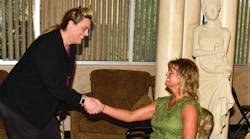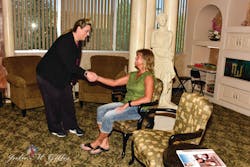Each patient walking through our doors deserves to be treated as a welcome guest. We are glad that they have come to see us! What works in our office may not work in yours as this process needs to be customized by each practice. It is my hope that this article provides guidelines that can be modified to fit your practice. A high-quality new-patient experience sets the tone for all that follows. The experience needs to be practiced until it is your office’s standard of care, consistent from day to day, team member to team member—for every patient.
The greeting
You know when a new patient is supposed to arrive. If other patients are scheduled at the same time, you should have their photos so you will easily recognize the new patient. By using a tool such as a telephone information slip on all new or emergency patients, you will already know a little about your important new patient.
Thank the patient for arriving on time. Say something nice! We usually say something like this: “Hello! You must be Jamie. Thank you for being right on time, and welcome to our office. My name is Shelly. I spoke with you last week. No one likes paperwork, but I have a couple of forms that I would like you to fill out for me.”
Please note here that many patients prefer to be addressed by their last name. You are never wrong to say, “Good afternoon, you must be Ms. Jones. Welcome to our office!” Ms. Jones then has the opportunity to say, “Please call me Jamie!” If your telephone information slip indicates the person is a doctor or has a similar title, by all means, use their title. They worked for it!
In our office reception area, we have hot coffee, a variety of teas, and hot chocolate, as well as a small refrigerator stocked with water and juices. Our patients may help themselves. We always let new patients know that these amenities are available.
We try to send our new patients any necessary paperwork ahead of their appointment so they have less to do when they arrive. We also have some patients fill out forms online, and then we already have the information entered when they arrive.
In our office, we try to schedule new patients at the start of our day or right after lunch when we are always on time. If your office begins seeing patients at 8:00 a.m., then you should always be ready for the first patient by 7:55 a.m. Lunches in dental offices are sometimes shortened if the morning patient runs later than expected. However, the first patient after lunch should always be seen on time.
If a new patient is scheduled at any other time and the office is running behind schedule, inform the new patient of the delay as soon as possible very pleasantly: “Ms. Jones, our treatment assistant, Julie, should be with you in about 10 minutes. I think you will really like her and Dr. Gillis.”
A treatment assistant has already been assigned to the new patient and has reviewed all of the information before that patient arrives. This is a very important step. No one likes to needlessly repeat information, and everyone likes to feel as if they are important. Before bringing the patient into the treatment area, the treatment assistant should walk into the reception area and warmly shake the patient’s hand (figure 1).The new-patient tour
Our office’s new-patient experience includes an office tour. Along with highlighting team members and the doctor, my treatment assistants point out the restroom, the sterilization area, our dental lab, where to find cold and hot drinks, and some of the special things we offer patients to make their care more comfortable. The assistants will often say: “I just want to give you a brief overview of our office so that you feel comfortable here.”
Team members are introduced to the patient. This allows the opportunity to gently show off our team’s skills. For example: “I think you will really like our talented hygienist, Melanie.” Try using the phrase “We are very proud of . . .” followed by things that you would like the patient to know about. For example: “Dr. Gillis and the entire dental team do our best to ensure that each patient is as comfortable as possible and very happy with their dentistry.”
Every team member should have at least four positive things that they like to introduce to new patients. You never know what the new patient already knows about your office. Even if the office offers a treatment that the new patient does not directly need, that same new patient may have a friend, neighbor, or relative who does need it. We love referrals from our patients. Patients like to see team members getting along and acting proud of one another, the dentist, and the office.
We also try to get the new patient talking about him- or herself. Ask every new patient something like this: “Please tell me about any past dental experiences you’ve had. Was there anything you liked or respected that we can repeat? Was there anything that wasn’t so good that we should try to avoid?” Find out what your new patient’s main concern is and be sure to address that early on in the appointment.
When it makes sense, and seemingly off the cuff, compliment the dentist. My assistants might say something along these lines: “Dr. Gillis was the very first dentist in Colorado to achieve accreditation in the American Academy of Cosmetic Dentistry. She is now part of an international group of examiners who evaluate other dentists working toward becoming accredited with the Academy. She even helps to create the written exam taken by dentists going through accreditation.” The team member might also say: “We are so proud of the beautiful work Dr. Gillis provides. If you or anyone you know is interested in cosmetic dentistry, or if you just want your dentistry to last a long time and be good-looking, we will do our very best to achieve this.”
You will have your own things to point out to patients about what makes you special. Dentists and team members should be able to easily answer this question: “Why should patients pick your office for their care?” Here are some of the things specific to our office that my team members point out to our new patients:
• “All the photos on our walls were taken by Dr. Gillis, and these are our patients showcasing her treatment. Dr. Gillis loves photography and travel, and you will see many of her photos in our treatment rooms.”
• They will point out “fun” equipment including lasers, digital and 3-D x-rays, in-office lab procedures, intraoral cameras, etc. (figure 2). These things are pretty common to us, but they may not be to our patients.
• Most of my dental team members have been with me for more than 15 years and some for more than 25º years. Why? Because we work well as a team, and we care about one another.
• You will probably hear laughter in our office. We think it is important and possible to have a fun and positive dental experience.
• Our office specializes in cosmetic dentistry, but we also treat many patients who just want a healthy, comfortable mouth.
• Our dental hygienists are very skilled in treating periodontal disease as well as completing regular, thorough, and comfortable dental cleanings.
• I recently became certified as a “laser dentist.” We have four different lasers in our office to treat a wide variety of issues, from speeding the healing of cold sores or ulcers, to advanced periodontal therapy, to completing fillings without shots.
• We have designed and outfitted our treatment rooms to be as comfortable for patients as possible. During dental treatment we can provide patients with headphones so they can listen to many different types of music, lip balm, blankets, a variety of pillows, nitrous oxide, and breaks whenever patients would like them.
• We always ask patients to let us know if there is anything that we can do to help them feel more comfortable. Our office receives many wonderful compliments about our care and our thoroughness, and yours will too!










